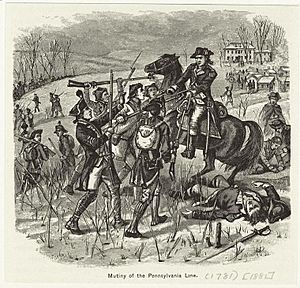Temperance Wick facts for kids
Quick facts for kids
Temperance Wick
|
|
|---|---|
| Born | October 30, 1758 Mendham, New Jersey, Colony of New Jersey
|
| Died | April 26, 1822 Morris County, New Jersey, United States
|
| Spouse(s) | William Tuttle |
| Parents |
|
| Relatives | Wick family |
Temperance Wick (born October 30, 1758 – died April 26, 1822), also known as Tempe Wick, was a brave woman from the American Revolutionary War. She is famous for a story about how she outsmarted some soldiers during the war. Many people see her as an example of patriotism, even though some parts of her story might be more legend than fact.
Contents
Tempe Wick's Early Life
Tempe Wick was born on October 30, 1758, in a place called Jockey Hollow in New Jersey. She was the youngest of five children in the wealthy Wick family. Her family was one of the oldest English families in America. Her father, Henry Wick, owned a lot of land and was a very important person in their area. We don't know much about Tempe's childhood. By the time she was 21, she and her brother Henry Jr. were the only children still living at home with their parents.
The Wick Family and the War
Tempe's father, Henry Wick, was a leader of the Morris County Cavalry. This group helped protect the government of New Jersey during the war.
The winter of 1779–1780 was extremely cold and difficult. It was known as the "Hard Winter." More than 10,000 American soldiers, called the Continental Army, set up their camp on the Wick family's huge 1,400-acre estate at Jockey Hollow. General Arthur St. Clair and his team even rented rooms in the Wick House.
Having so many soldiers nearby put a big strain on the local community. The troops didn't have enough warm clothes or food. Many soldiers had to walk barefoot in the snow. Sadly, about 100 soldiers died that winter and were buried near the Wick House.
Tempe's Brave Act: The Pennsylvania Line Mutiny
The soldiers at Jockey Hollow had not been paid for a long time, even after asking the government many times. This made them very unhappy. In late December 1780, over a thousand soldiers decided to protest. This event is known as the Pennsylvania Line Mutiny. They planned to march to Philadelphia to demand their pay directly from Congress. These protesting soldiers spent several days looking for food and horses in the countryside.
On December 21, 1780, Tempe's father, Henry Wick, passed away. This left Tempe to care for her sick mother, Mary, and her brother, Henry, who was also unwell. When her mother's health got worse, Tempe quickly saddled her horse. She rode to find Doctor William Leddell, who lived about a mile away. The doctor wasn't home, so Tempe left a message and headed back.
On her way home, three of the protesting soldiers stopped her. One of them grabbed her horse's bridle and demanded that she give them her horse. Tempe pretended to agree. But when the soldier let go of the bridle to help her down, she quickly whipped her horse and galloped home. She made it back safely, but she worried the soldiers would follow her and take the horse by force.
Hiding the Horse
One popular version of the story says that Tempe led her horse right into the house. She hid it in a guest bedroom! She closed the window shutters and put a soft feather bed under the horse's hooves to muffle any sounds. Soon after, the soldiers arrived and searched the barns and woods around the house. But they left without finding the horse. Tempe supposedly kept her horse hidden in the bedroom until New Year's Day, when the soldiers marched south.
Another version of the story says Tempe hid her horse in the kitchen. Today, visitors to the Wick House at Jockey Hollow sometimes claim they can see a faint imprint of a horse's shoe in one of the bedrooms.
The Wick House is still standing today and is part of the Morristown National Historical Park. Visitors can even see the bedroom where Tempe is said to have hidden her horse!
Tempe's Later Life
After her mother, Mary, died on July 7, 1787, Tempe inherited the family estate at Jockey Hollow. When she was 30, which was considered a bit late for that time, she married Doctor William Tuttle. They had five children together.
Is the Story True?
Historians and experts have different ideas about how much of Tempe Wick's story is completely true. While she and her parents are mentioned in many old letters and records from that time, some parts of the famous horse-hiding story might have been exaggerated over the years. It's common for heroic tales to grow into legends!
Tempe Wick in Books
Tempe Wick's story has inspired many writers.
- The American storyteller Frank R. Stockton wrote a short story about her. His version focused on the patriotic spirit of American girls. However, many experts believe Stockton added his own details to the legend.
- Ann Rinaldi's historical novel A Ride Into Morning tells Tempe's story from the point of view of her cousin, Mary Cooper.
- Patricia Lee Gauch's book, "This Time, Tempe Wick?", is a popular children's book about her.
See also
- Tempe Wick Road–Washington Corners Historic District
- New Jersey Brigade Encampment Site
- Jockey Hollow


